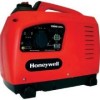Honeywell HW1000i Owners Manual - Page 17
Operation, Generator Location, Preparing for Operation - parts
 |
UPC - 894190002186
View all Honeywell HW1000i manuals
Add to My Manuals
Save this manual to your list of manuals |
Page 17 highlights
OPERATION Generator Location When deciding on the location to place your generator, keep in mind the following safety rules: DANGER Depressed areas such as construction foundations, pools, or any low-lying areas, can cause carbon monoxide to accumulate. Inhalation of carbon mon+ oxide can kill you in minutes. • NEVER use generator inside homes, garages, crawl spaces, sheds, or similar enclosed spaces. Use generator only outdoors and far away from windows, doors, and vents. WARNING If generator is placed on an uneven or flexible surface, generator could tilt or overturn, causing fuel to spill from gas tank. Spilled fuel could ignite. • Place generator on firm, level surface and avoid loose sand or snow. If generator is tilted or overturned, fuel spillage may result. Also, if generator is overturned or sinks into a soft surface, sand, dirt, or water may enter generator. WARNING NEVER operate generator in rain or snow, or when the generator is set on wet surface. WARNING Keep generator at least 6 feet (2 meters) away from buildings, other equipment, and combustible materials during operation. Preparing for Operation DANGER CARBON MONOXIDE Generator exhaust contains high levels of carbon monoxide (CO), a poisonous gas you cannot see or smell. If you can smell the generator exhaust, you are breathing CO. But even if you cannot smell the exhaust, you could be breathing CO. • NEVER use a generator inside homes, garages, crawlspaces, or other partly enclosed areas. Deadly levels of carbon monoxide can build up in these areas. Using a fan or opening windows and doors does NOT supply enough fresh air. • ONLY use a generator outdoors and far away from open windows, doors, and vents. These openings can pull in generator exhaust. Even when you use a generator correctly, CO may leak into the home. ALWAYS use a battery-powered or batterybackup CO alarm in the home. If you start to feel sick, dizzy, or weak after the generator has been running, move to fresh air RIGHT AWAY. See a doctor. You could have carbon monoxide poisoning. Before starting generator, complete the following preparation tasks: ‰ Be sure generator is placed outdoors in a well ventilated area. Using a generator indoors CAN KILL YOU IN MINUTES. ‰ Check/add engine oil- IMPORTANT! BEFORE STARTING GENERATOR, FILL WITH ENGINE OIL. See page 18-21 for instructions on filling, checking, and changing oil. ‰ Check/add fuel-ADD FUEL. See page 22. ‰ Check air filter-See "Air Filter Maintenance" on page 23. ‰ If required, connect ground terminal to a grounding electrode-See "Grounding the Generator" on page 6. ‰ Check extension cords-be sure cords are: „ In good condition. „ Rated for outdoor use and match amperage and voltage ratings of generator outlet. „ Equipped with plugs that have a ground terminal. HW1000i / HW2000i Inverter Generator Owner's Manual www.honeywellgenerators.com 11















